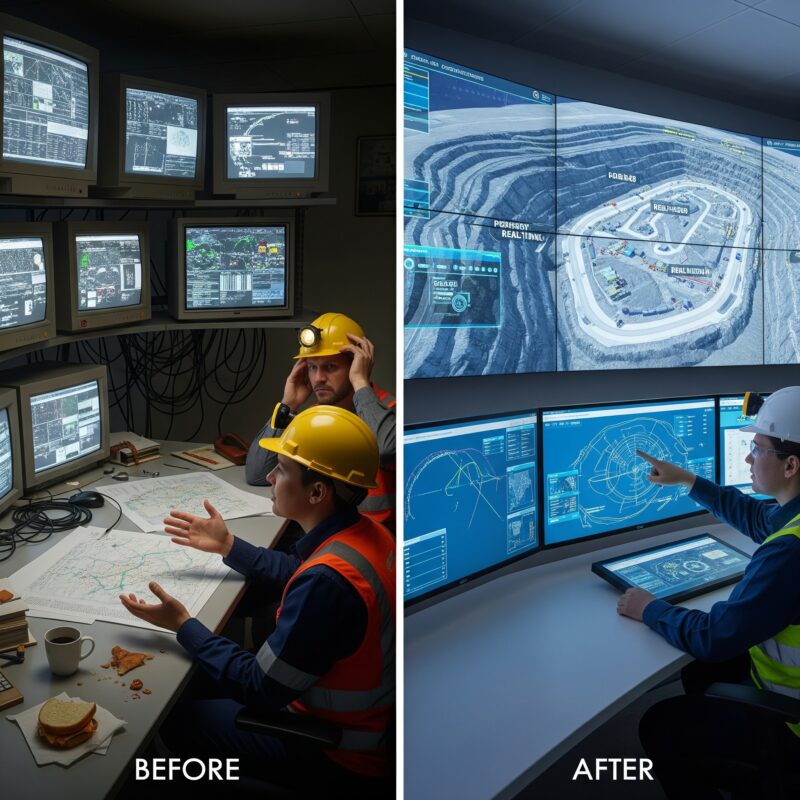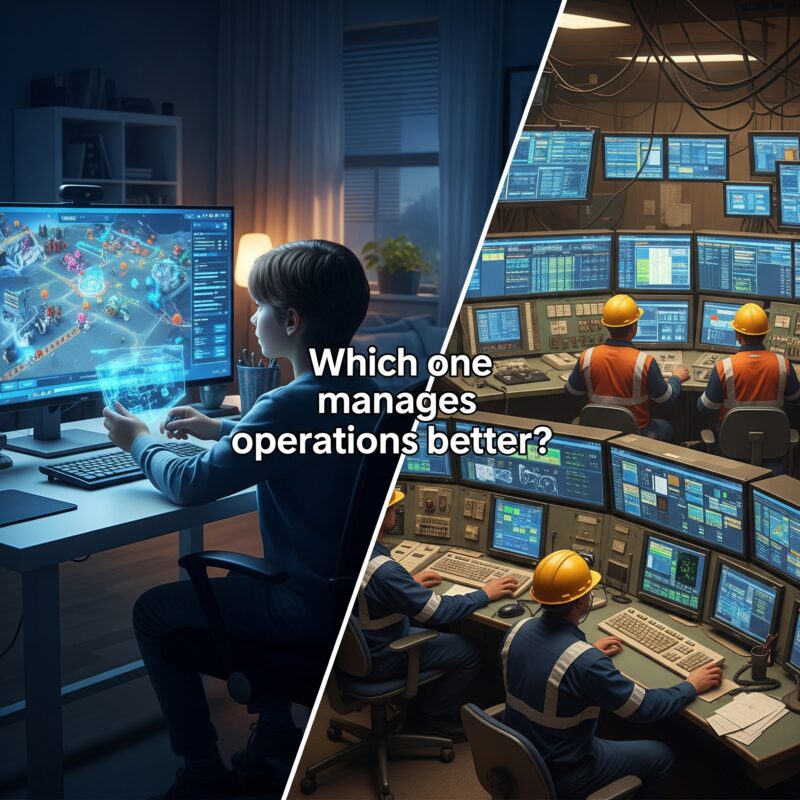The most advanced operational control system I’ve ever seen wasn’t in a mine. It was in my nephew’s bedroom.
He was playing a strategy game that required him to manage resources, coordinate multiple units, respond to emergencies, and optimize production across a complex 3D environment. Sound familiar? He was essentially running a virtual mining operation – and doing it with more situational awareness, faster decision-making, and better coordination than most real mining control rooms.
That’s when it hit me: if gaming technology can help a 14-year-old manage complex operations intuitively, why are we still running multi-billion-dollar mining operations with interfaces that look like they’re from 1995?
After 20 years in mining operations, I’m convinced that the future of mining control rooms isn’t just digital – it’s dimensional. And the technology to build it already exists.
The Control Room Reality Check
Walk into most mining control rooms today and you’ll see the same setup that’s been standard for decades:
Multiple flat screens showing different system interfaces that don’t talk to each other. Spreadsheets with production numbers that are already 2 hours old. Radio chatter that dispatchers have to mentally translate into spatial understanding. Paper maps with hand-drawn equipment locations. Separate screens for weather, maintenance, safety alerts, and production tracking.
The result? Operations managers trying to build 3D situational awareness from 2D puzzle pieces, making critical decisions with incomplete information, and coordinating complex operations through mental gymnastics.
Meanwhile, the gaming industry has spent $200 billion developing technology that creates perfect situational awareness, enables intuitive decision-making, and supports real-time collaboration in complex 3D environments.
We’re using Stone Age tools to run Space Age operations.

What Gaming Technology Actually Offers Mining
This isn’t about making mining “fun” or adding flashy graphics. This is about using proven technology to solve fundamental operational challenges that cost mining companies millions of dollars annually.
Real-Time 3D Situational Awareness
Current state: Dispatcher Shannon knows Truck 47 is “somewhere on the dump” because that’s what the FMS shows on a tiny 2D static map.
Gaming / Ai technology potential: Shannon uses a over the shoulder view to see Truck 47 in real-time 3D, approaching the dozer queue, with clear visual indicators showing it will arrive in 2.3 minutes, there are already 2 trucks waiting, and they can see contextually that a trainee is struggling to align with the tip edge causing delays.
The difference: Instant understanding vs. mental translation. Predictive awareness vs. reactive response. In fact, research at 3M Corporation concluded that we process visuals 60,000 times faster than text. It’s not even close.
Intuitive Decision-Making Interfaces
Current state: Rerouting a truck can require navigating through multiple software menus, updating databases, and hoping the operator gets the radio message correctly in a sea of radio chatter.
Gaming / Ai technology potential: Click on mic, say the reserved keyword Reroute followed by the truck ID to location (reserved keyword), see instant route calculation and impact on production flow. One action, Ai guided workflow implemented, immediate visual feedback, automatic communication to operator, play call decision logged in context. In autonomous mines this would be done automatically.
The difference: Natural interaction vs. software fighting. Immediate understanding of consequences vs. hoping for the best.
Multi-User Collaboration in Shared Environments
Current state: General Supervisor, shift supervisor, and dispatcher all looking at different screens, trying to coordinate on the mine plans execution through radio calls and separate conversations.
Gaming technology potential: All three users in the same 3D environment, seeing the same real-time operation, able to point to specific locations, share annotations, and coordinate responses with perfect context.
The difference: Shared understanding vs. communication gaps. Coordinated decisions vs. isolated assumptions.
The Technology is Already Here
The tools to build this future exist today. The gaming industry has solved every technical challenge required for immersive mining operations:
Real-Time 3D Rendering
Modern game engines can render massive, detailed environments with hundreds of moving objects at 60+ frames per second on standard hardware. A mine site is actually less complex than most modern video games.
Physics Simulation
Games accurately simulate vehicle movement, terrain interaction, weather effects, and collision detection. These same systems can model haul truck behavior, road conditions, and equipment constraints.
Network Architecture
Multiplayer games coordinate actions among dozens of players across global networks with millisecond precision. Mining operations typically involve fewer users in smaller geographic areas.
User Interface Design
Game developers have spent decades perfecting interfaces that allow complex decision-making through intuitive interactions. These same principles apply directly to operational control.
Artificial Intelligence Integration
Modern games use AI for everything from pathfinding to strategic decision support. Mining operations need exactly the same capabilities.
Real-World Example: What This Actually Looks Like
Let me paint a picture of what a gaming-technology-powered mining control room would actually look like in practice:
9:15 AM – Normal Operations
Mine Manager Dave sees the entire operation from a strategic overview – production rates flowing like colored streams from pits to crushers, equipment health indicators glowing green, and progress toward daily targets tracking visually in real-time.
Shift Supervisor Lisa focuses on her section, watching equipment coordination like pieces on a 3D chess board, understanding immediately why trucks are bunching up at loading points or when operator break schedules will impact production flow.
Dispatcher Carlos manages individual equipment movements with the precision of a real-time strategy game, coordinating 48 trucks across 3 loading points with drag-and-drop simplicity and instant visual feedback.
All three see the same operation from their perspective, all three have access to built in Ai assistants for every conceivable task, with the ability to zoom in or out of context, share annotations, and coordinate highly strategic decisions with perfect context.
9:22 AM – Equipment Breakdown
Excavator EX-12 throws a hydraulic fault. In traditional control rooms, this would trigger a series of phone calls, radio messages, and manual status updates across multiple systems.
In the gaming-enhanced control room:
- EX-12 immediately changes color, begins pulsing and displays fault information in 3D space
- The in-game Ai sees the 4 trucks heading to excavator EX-12 and can instantly reroute them with or without human intervention
- Lisa watches the impact ripple through production flow and with Ai’s help adjusts break schedules accordingly and in alignment with the terms of the collective bargaining agreement.
- The Mine Manager Ai sees the overall production impact and authorizes overtime to recover targets
- Maintenance receives automatic work order with exact location, fault details, and priority level
Total response time: 90 seconds instead of 15 minutes. Coordination errors: Zero instead of typical confusion.
The Game-Changer: Predictive “What-If” Scenarios
The most powerful aspect isn’t just seeing current operations – it’s the ability to model changes before implementing them.
Traditional approach: “Let’s try rerouting trucks to Crusher 2 and see what happens.”
Gaming approach: Test the change in simulation mode, see the projected impact on production flow, identify potential bottlenecks, optimize the solution, then implement with confidence.
It’s like having a save/reload function for mining operations.
Beyond Pretty Pictures: The Real Operational Benefits
This isn’t about impressive visuals. It’s about solving fundamental operational challenges that cost money and create risks:
Faster Emergency Response
Current average: 8-15 minutes from incident to coordinated response
3D gaming approach: 2-4 minutes with better coordination and fewer errors
Annual value for typical large mines: $2-50 million in reduced downtime and improved safety response
Improved Training and Onboarding
Current approach: Months of shadowing experienced operators, learning through trial and error
Gaming approach: Immersive simulation training where new operators can safely practice thousands of scenarios
Training time reduction: 40-60% with better retention and competency
Enhanced Cross-Team Communication
Current challenge: “The problem is near the old fuel island location, you know, where we had the issue last month”
Gaming solution: Point directly to locations, share visual context, eliminate ambiguity
Communication error reduction: 70-80% with measurable impact on operational efficiency
Predictive Decision Making
Current limitation: Decisions based on experience and gut feeling
Gaming enhancement: Model outcomes before implementation, optimize strategies through simulation
Decision quality improvement: 25-40% better outcomes through enhanced situational awareness
The Resistance: “That’s Not How We Do Things”
Every mining professional reading this is thinking some version of: “Mining operations are serious business, not video games.”
You’re absolutely right. And that’s exactly why we need better tools.
The Aviation Parallel
Commercial aviation figured this out decades ago. Modern aircraft cockpits use 3D displays, immersive interfaces, and game-like simulation for training. Why? Because when lives and millions of dollars are at stake, you use the best possible technology for situational awareness and decision-making.
Nobody says airplane cockpits are “too much like video games.” They say they’re incredibly effective at preventing accidents and optimizing performance.
The Military Example
Military command centers use real-time 3D mapping, collaborative planning environments, and simulation-based decision support. Not because war is a game, but because effective coordination saves lives and resources.
The technology that helps generals coordinate complex operations can help mine managers coordinate complex operations.
The Manufacturing Reality
Modern manufacturing plants use 3D digital twins, real-time simulation, and immersive control interfaces. Not for entertainment, but because they enable faster responses, better decisions, and improved efficiency.
If it’s good enough for building cars and aircraft, it’s good enough for mining.
The Gaming Generation is Already Here
Here’s the reality that traditional mining operations haven’t fully grasped: the next generation of mining professionals grew up with sophisticated gaming interfaces. They expect intuitive, visual, responsive technology.
New mining engineers have managed thousand-unit armies in real-time strategy games
Young operators have coordinated complex logistics in simulation games
Recent graduates have solved spatial puzzles in 3D environments since childhood
They’re going to look at traditional mining interfaces the same way you’d look at a computer from 1985: primitive and unnecessarily difficult.
Companies that embrace gaming technology will attract and retain the best talent. Companies that don’t will struggle to find people willing to work with outdated tools.
The Choice: Lead or Follow
Mining operations are about to undergo their biggest technological transformation since GPS and computers.
The question isn’t whether gaming technology will revolutionize mining control rooms. The question is whether your operation will lead that revolution or be forced to follow it.
Early adopters will help shape the technology, gain competitive advantages, and attract top talent.
Fast followers will implement proven solutions but miss the opportunity to influence development.
Laggards will eventually be forced to upgrade to remain competitive, but at higher costs and lower benefits.
The Bottom Line
Your next control room should look like a video game because video games have solved the same problems you face every day: coordinating complex operations, making fast decisions with incomplete information, and managing multiple variables in real-time.
The technology exists. The benefits are proven. The competitive advantages are significant.
The only question is: are you ready to give your operations team the tools they deserve?
Ready to see mining operations in 3D? Whether you’re interested in early access, want to contribute operational expertise, or just want to learn more about the future of mining control rooms, let’s connect. The future of mining operations is being built now – and it looks nothing like the past.

